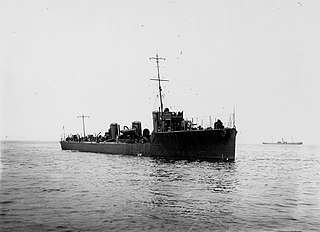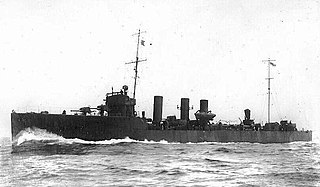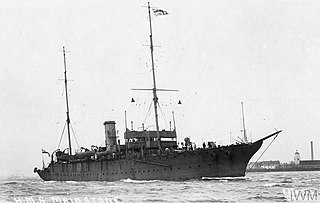The 5th Battle Squadron was a squadron of the British Royal Navy consisting of battleships. The 5th Battle Squadron was initially part of the Royal Navy's Second Fleet. During the First World War, the Home Fleet was renamed the Grand Fleet.

HMS Albemarle was a pre-dreadnought Duncan-class battleship of the Royal Navy, named after George Monck, 1st Duke of Albemarle. Built to counter a group of fast Russian battleships, Albemarle and her sister ships were capable of steaming at 19 knots, making them the fastest battleships in the world. The Duncan-class battleships were armed with a main battery of four 12-inch (305 mm) guns and they were broadly similar to the London-class battleships, though of a slightly reduced displacement and thinner armour layout. As such, they reflected a development of the lighter second-class ships of the Canopus-class battleship. Albemarle was built between her keel laying in January 1900 and her completion in November 1903.

HMS Shark, was an Acasta-class destroyer built in 1912 for the Royal Navy. Shark was sunk during the Battle of Jutland on the evening of 31 May 1916.

HMS Turbulent was one of four Talisman-class destroyers ordered for the Ottoman Navy and taken over by the Royal Navy during the First World War.
The 6th Battle Squadron was a squadron of the British Royal Navy consisting of Battleships serving in the Grand Fleet and existed from 1913 to 1917.

HMS Grafton was a first class cruiser of the Edgar class, launched in 1892. She served in colonial service and in the First World War. Grafton survived the war and was broken up in the 1920s.

Admiral Sir Henry Daniel Pridham-Wippell, was a Royal Navy officer who served in the First and Second World Wars.

HMS Defender was an Acheron-class destroyer which was built in 1911, served throughout World War I and was broken up in 1921. She was the fifth ship of the name to serve in the Royal Navy.

The 2nd Battle Squadron was a naval squadron of the British Royal Navy consisting of battleships. The 2nd Battle Squadron was initially part of the Royal Navy's Grand Fleet. After World War I the Grand Fleet was reverted to its original name, the Atlantic Fleet. The squadron changed composition often as ships were damaged, retired or transferred.
The 3rd Battle Squadron was a naval squadron of the British Royal Navy consisting of battleships and other vessels, active from at least 1914 to 1945. The 3rd Battle Squadron was initially part of the Royal Navy's Home Fleet. During the First World War, the Home Fleet was renamed the Grand Fleet. During the Second World War, the squadron covered Atlantic convoys.

The 4th Battle Squadron was a squadron of the British Royal Navy consisting of battleships. The 4th Battle Squadron was initially part of the Royal Navy's Home Fleet (1912–14) and then the Grand Fleet after the outbreak of the First World War. The squadron changed composition often as ships were damaged, retired or transferred.

The 3rd Battlecruiser Squadron was a short-lived Royal Navy squadron of battlecruisers that saw service as part of the Grand Fleet during the First World War.

The First Battlecruiser Squadron was a Royal Navy squadron of battlecruisers that saw service as part of the Grand Fleet during the First World War. It was created in 1909 as the First Cruiser Squadron and was renamed in 1913 to First Battle Cruiser Squadron. It participated in the battles of Heligoland Bight, Dogger Bank and the Battle of Jutland. After the end of the war it became the sole Battlecruiser Squadron.

The 2nd Battlecruiser Squadron was a Royal Navy squadron of battlecruisers that saw service as part of the Grand Fleet during the First World War.

The 9th Battle Squadron was a short-lived squadron of the British Royal Navy consisting of battleships serving in the Grand Fleet.
HMS Ophelia was an Admiralty M-class destroyer built for the Royal Navy during the First World War, entering service in 1916. The ship served at the Battle of Jutland on 31 May/1 June 1916, and sank a German submarine in 1918. She was sold for scrap in 1921.
HMS Onslow was an Admiralty M-class destroyer built for the Royal Navy during the First World War. She took part in the Battle of Jutland in 1916 and was sold for scrap in 1921.
HMS Narborough was an Admiralty M-class destroyer built for the Royal Navy during the First World War. She was wrecked after running aground in 1918.
The Commander in Chief, Dover was an operational commander of the Royal Navy. His subordinate units, establishments, and staff were sometimes informally known as the Dover Command.

HMS Maidstone was a submarine depot ship of the Royal Navy. She was purpose built to support 12 of the new 'D' Class submarines under the 1910/11 Naval Programme.













